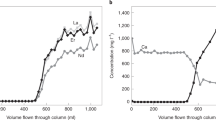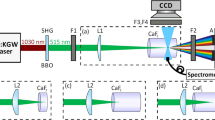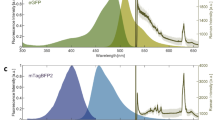Abstract
PROF. F. RASETTI1 has described lines in the Raman spectrum of fluorite and calcite, which show a remarkably large shift of about 7000 cmâ1. Owing to the theoretical importance of this fact, which would indicate the co-operation of electronic transitions of considerable energy in the Raman spectra, I wish to point out that these lines can be explained as lines of the phosphorescence of gadolinium. It is a wellknown fact that natural fluorite nearly always contains rare earths. These earths, when excited by ultra-violet light or cathode rays, show a phosphorescence having a spectrum of very sharp lines. The spectrum of fluorite was examined by G. Urbain.2 The following table shows that the observed lines coincide with the lines of phosphorescence of gadolinium.
This is a preview of subscription content, access via your institution
Access options
Subscribe to this journal
Receive 51 print issues and online access
$199.00 per year
only $3.90 per issue
Buy this article
- Purchase on SpringerLink
- Instant access to full article PDF
Prices may be subject to local taxes which are calculated during checkout
Similar content being viewed by others
References
NATURE, April 25, 1931, p. 626.
Ann. de chim., 1909, and "Handb. d. Experimentalphysik", 23, 484; 1928.
Author information
Authors and Affiliations
Rights and permissions
About this article
Cite this article
TOMASCHEK, R. Lines of Large Frequency Shift in the Raman Spectra of Crystals. Nature 128, 495 (1931). https://doi.org/10.1038/128495a0
Issue date:
DOI: https://doi.org/10.1038/128495a0
This article is cited by
-
An Inhibitor of the Antimony Trichloride Test for Vitamin A in Cod Liver Oil
Nature (1933)
-
Sopra l’effetto Raman nei cristalli
Il Nuovo Cimento (1932)



